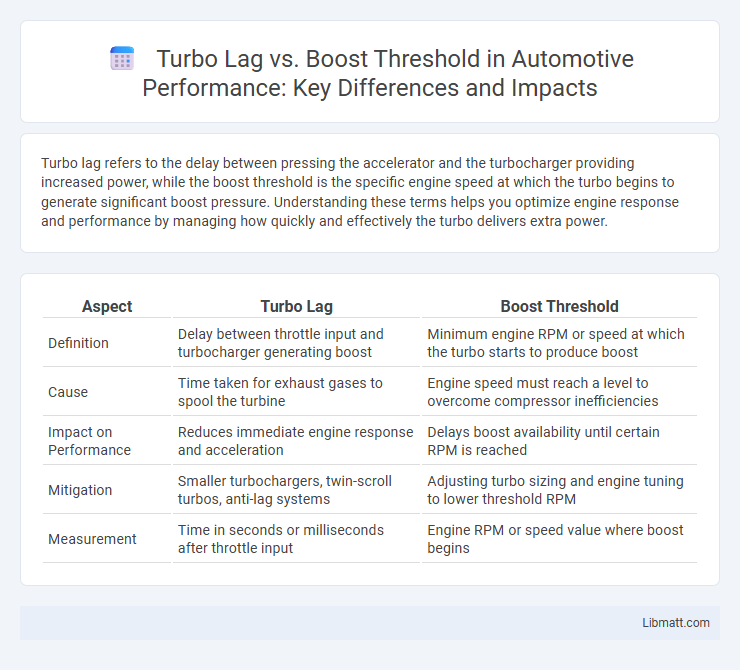Turbo lag refers to the delay between pressing the accelerator and the turbocharger providing increased power, while the boost threshold is the specific engine speed at which the turbo begins to generate significant boost pressure. Understanding these terms helps you optimize engine response and performance by managing how quickly and effectively the turbo delivers extra power.
Table of Comparison
| Aspect | Turbo Lag | Boost Threshold |
|---|---|---|
| Definition | Delay between throttle input and turbocharger generating boost | Minimum engine RPM or speed at which the turbo starts to produce boost |
| Cause | Time taken for exhaust gases to spool the turbine | Engine speed must reach a level to overcome compressor inefficiencies |
| Impact on Performance | Reduces immediate engine response and acceleration | Delays boost availability until certain RPM is reached |
| Mitigation | Smaller turbochargers, twin-scroll turbos, anti-lag systems | Adjusting turbo sizing and engine tuning to lower threshold RPM |
| Measurement | Time in seconds or milliseconds after throttle input | Engine RPM or speed value where boost begins |
Introduction to Turbo Lag and Boost Threshold
Turbo lag describes the delay between throttle input and the turbocharger's spool-up, resulting from the time needed for exhaust gases to increase turbine speed. Boost threshold refers to the minimum engine RPM or exhaust flow required to generate effective turbocharger boost pressure. Understanding the relationship between turbo lag and boost threshold is essential for optimizing engine responsiveness and performance in forced induction systems.
Defining Turbo Lag: Causes and Effects
Turbo lag refers to the delay between pressing the accelerator and the turbocharger providing increased engine power. It occurs because the turbo needs time to spool up as exhaust gases build pressure, causing a temporary lack of boost and reduced throttle response. Understanding this delay helps you optimize driving techniques and modifications to minimize turbo lag and enhance overall performance.
Understanding Boost Threshold: What It Means
Boost threshold refers to the minimum engine speed at which a turbocharger starts generating noticeable boost pressure, directly impacting your vehicle's responsiveness. A lower boost threshold reduces turbo lag, allowing power to build earlier in the RPM range and improving acceleration. Understanding this concept helps optimize turbo performance for smoother and more immediate power delivery.
Key Differences Between Turbo Lag and Boost Threshold
Turbo lag refers to the delay between throttle input and actual boost pressure build-up caused by the turbocharger spooling up, while boost threshold is the specific engine speed or RPM at which the turbo begins to generate measurable boost pressure. Turbo lag duration depends on factors such as turbo size, exhaust gas flow, and inertia, leading to slower response in larger turbos, whereas boost threshold is a fixed RPM point determined by turbocharger design and compressor characteristics. Understanding these key distinctions is crucial for tuning performance engines, as minimizing turbo lag improves throttle response while managing boost threshold ensures optimal power delivery.
How Turbo Lag Affects Driving Performance
Turbo lag significantly impacts driving performance by causing a delay between throttle input and engine response, reducing acceleration smoothness and immediate power availability. This delay occurs because the turbocharger requires time to spool up and reach the boost threshold where it delivers increased air pressure to the engine. As a result, drivers often experience a temporary drop in engine power, which can affect overtaking maneuvers and overall driving dynamics.
Boost Threshold Impact on Engine Response
Boost threshold significantly affects engine response by determining the RPM at which the turbocharger starts producing usable boost pressure. A lower boost threshold reduces turbo lag, enabling quicker throttle response and improved acceleration for your vehicle. Optimizing this parameter enhances overall driving performance by ensuring the turbo engages promptly when demand increases.
Engineering Solutions to Reduce Turbo Lag
Engineering solutions to reduce turbo lag focus on optimizing boost threshold by improving turbocharger responsiveness through techniques like variable geometry turbochargers (VGT) and twin-scroll designs, which enhance exhaust gas flow and maintain higher boost pressure at lower RPMs. Advanced electronic boost control systems and lightweight turbine wheels also contribute to quicker spool times, minimizing the delay between throttle input and turbo boost delivery. Your vehicle's performance benefits significantly from these technologies, as they provide smoother power delivery and reduced lag without sacrificing overall boost efficiency.
Modifying Boost Threshold for Better Performance
Modifying the boost threshold in a turbocharged engine reduces turbo lag by allowing the turbocharger to spool earlier, enhancing throttle response and overall performance. Lowering the boost threshold enables the turbo to generate pressure at lower RPMs, improving acceleration and drivability in everyday driving conditions. Precisely tuning boost threshold parameters optimizes turbo efficiency, maximizing power output without sacrificing engine reliability or fuel economy.
Real-World Examples: Turbo Lag vs Boost Threshold
Turbo lag occurs when there is a delay in power delivery as the turbocharger spools up, commonly experienced in older turbocharged cars like the first-generation Subaru WRX, where the delay can be noticeable at low RPMs. Boost threshold refers to the minimum engine speed at which a turbocharger begins generating effective boost pressure, exemplified by the Volkswagen Golf GTI's turbo setup that delivers boost quickly due to a low boost threshold, providing more immediate throttle response. Understanding these differences helps you anticipate driving characteristics and select vehicles with either quick throttle response or significant top-end power.
Choosing the Right Turbocharger for Your Needs
Selecting the right turbocharger involves balancing turbo lag and boost threshold to match your driving style and engine requirements. A smaller turbocharger typically offers low boost threshold and minimal turbo lag, enhancing responsiveness in daily driving, while larger turbos provide higher peak power but at the cost of increased lag. Understanding your vehicle's intended use and performance goals ensures optimal turbo sizing for efficient power delivery and driving satisfaction.
turbo lag vs boost threshold Infographic

 libmatt.com
libmatt.com